
Choosing where to stay in Rio de Janeiro is one of the most important decisions of your trip, as it can directly impact your experience.
The right location can provide not only convenience but also comfort and safety, allowing you to make the most of everything the city has to offer.
Rio de Janeiro is a large city with many areas to choose from for your stay. However, the best place to stay in Rio is undoubtedly the Zona Sul (South Zone), which stands out as the top area for most visitors, especially the neighborhoods of Copacabana, Ipanema, and Leblon.
This region is widely recognized for its excellent tourist infrastructure, great hotels, relative safety, and proximity to the city’s main attractions, such as the famous beaches, Christ the Redeemer, and Sugarloaf Mountain.
But don’t limit yourself to the Zona Sul! Rio also has other neighborhoods that might be a better fit depending on your style, preferences, or travel purpose. Each area offers unique experiences that cater to different kinds of travelers.
In this guide, we will explore in detail the best neighborhoods to stay in Rio de Janeiro, highlighting their characteristics, advantages, and disadvantages.
From a geographic perspective, Rio de Janeiro is divided into different zones that help organize the city and understand its features:
1. South Zone: This is the most touristy and famous area, including neighborhoods like Copacabana, Ipanema, and Leblon, known for their beaches, high-quality hotel infrastructure, and proximity to landmarks such as Christ the Redeemer.
2. West Zone: Home to Barra da Tijuca, this area stands out for its quieter beaches, a wide range of shopping malls, and modern hotels, making it ideal for families and travelers seeking peace and relaxation.
3. Central Zone: Also known as the Centro, this area includes neighborhoods like Lapa and Santa Teresa, which combine history, culture, and vibrant nightlife. It’s also close to attractions like the Museum of Tomorrow and other cultural hotspots.
4. North Zone: While not as popular for accommodations, this zone is home to important tourist sites like the Maracanã Stadium and Quinta da Boa Vista. It’s a region more commonly visited during the day.
Check the map below to see the location of each region and best neighborhoods (the blue markers represent the regions, while the red ones indicate the best neighborhoods):
Next, we’ll explore each of these regions in detail, highlighting their most popular neighborhoods among travelers to help you plan your stay.

The South Zone (Zona Sul), as previously mentioned, is the preferred region for tourists visiting Rio de Janeiro, especially for first-time travelers.
This area stands out for its comprehensive infrastructure, efficient public transportation, proximity to the city’s most iconic attractions, and reputation as one of the safest places to stay in Rio, thanks to frequent policing and constant pedestrian traffic.
The South Zone offers accommodation options for every budget and travel style, ranging from luxury hotels and apartments to hostels and guesthouses.
Additionally, the area is home to a wide variety of restaurants, bars, and beachfront kiosks that cater to all tastes, whether you’re looking for a gourmet meal or something more casual and affordable.
However, there are a few downsides to consider. Despite offering options for different budgets, prices in the South Zone tend to be higher compared to other parts of the city.
During peak seasons, such as summer or major events like Carnival and New Year’s Eve, the influx of visitors increases significantly. This can lead to crowded beaches, heavy traffic, and greater competition for hotel rooms.
Next, let’s dive into the most popular neighborhoods in the South Zone and discover why they stand out as favorites among travelers.
👉 Find the best hotels on Hoteis.com in Copacabana, Ipanema, and nearby areas — from beachfront resorts to cozy boutique stays. If you’re traveling on a budget, browse affordable hostels on Hostelworld.
Copacabana
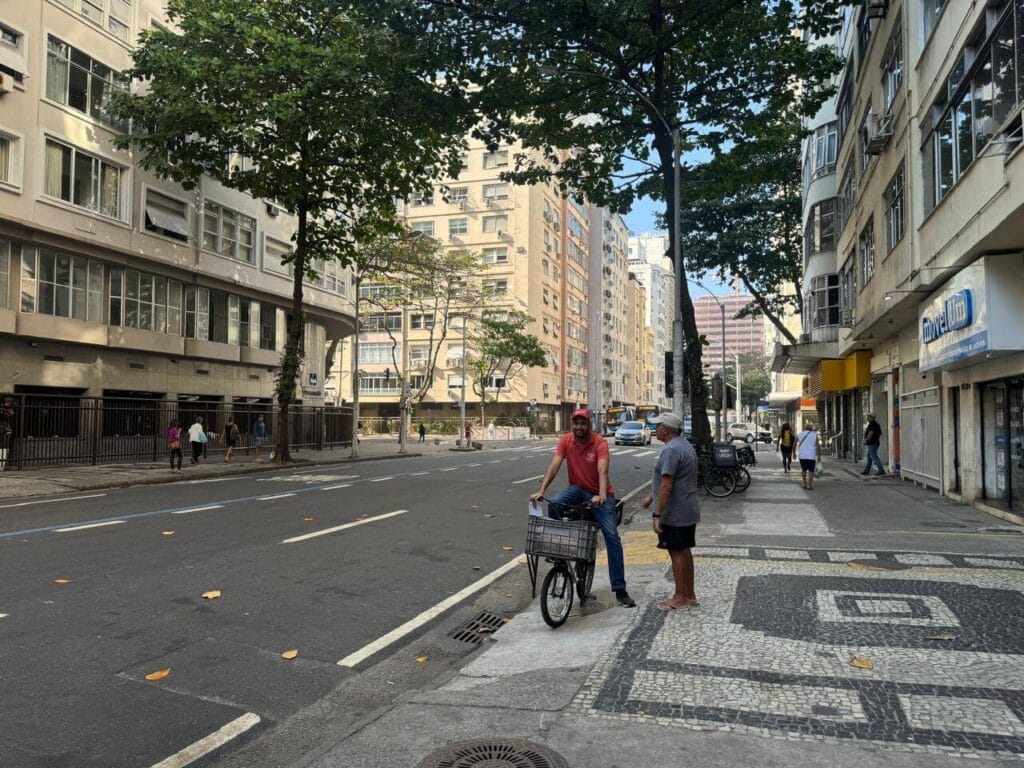
Copacabana is undoubtedly one of the most famous neighborhoods in Rio de Janeiro and Brazil. Known for its iconic beach and the black-and-white wave-patterned promenade, Copacabana is a true symbol of the Marvelous City.
The neighborhood combines charm, accessibility, and top-tier tourist infrastructure, making it a popular choice for visitors from around the world.
One of the biggest advantages of staying in Copacabana is its proximity to various tourist attractions.
In addition to its stunning beach, perfect for walks, sunbathing, and outdoor sports, you’ll find yourself just minutes away from other key landmarks such as Sugarloaf Mountain, Christ the Redeemer, and nearby beaches like Ipanema and Leme.
The neighborhood also offers convenient access to the metro, allowing quick travel to the City Center, Lapa, and other regions.
Copacabana’s infrastructure is another major highlight, widely regarded as the best for tourists. Packed with hotels, restaurants, bars, and shops, the area caters to all tastes and budgets.
From luxurious beachfront hotels to boutique accommodations and cozy guesthouses, Copacabana is ideal for both those seeking sophistication and budget-conscious travelers.
The dining scene is equally diverse, offering everything from international cuisine to traditional Brazilian “botequins.”
However, being such a busy and popular neighborhood, Copacabana does come with some downsides.
Traffic can be heavy during peak hours, and the streets near the beach are often crowded, especially during high season and major events like New Year’s Eve, when millions gather along the shore to celebrate.
Safety in Copacabana is a key consideration for anyone planning to stay in the neighborhood. As one of the most visited areas in Rio, it has a strong police presence, especially along the promenade, tourist sites, and main avenues.
During large events like New Year’s Eve, security is intensified, enhancing the feeling of safety in these areas.
That said, the high concentration of people can attract petty crimes like pickpocketing, particularly during busy times or in crowded areas like the promenade and beach entrances.
It’s essential to take basic safety precautions, such as avoiding the display of valuable items, keeping an eye on your belongings, and avoiding isolated streets, especially at night.
Ipanema
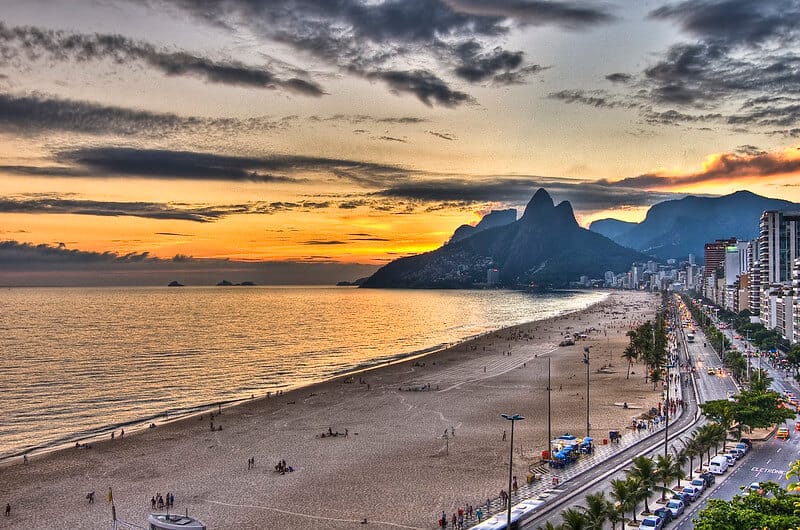
Ipanema is one of the most sophisticated neighborhoods in Rio de Janeiro. Located in the South Zone, between Copacabana and Leblon, Ipanema combines one of the world’s most beautiful beaches with a cosmopolitan and lively atmosphere.
Beyond the beach, Ipanema is renowned for its elegance. The area is filled with high-end boutiques, art galleries, charming cafés, and award-winning restaurants that range from international cuisine to traditional Brazilian dishes.
This blend of sophistication and variety makes it a favorite among visitors looking for an upscale experience.
Another significant advantage of Ipanema is its strategic location. Like Copacabana, it is close to major tourist attractions such as Christ the Redeemer and Sugarloaf Mountain.
Additionally, the neighborhood’s metro station makes it easy to reach other parts of the city, including downtown Rio and neighboring Copacabana.
When it comes to accommodations, Ipanema offers equally sophisticated options. The neighborhood boasts several luxury hotels, while more budget-friendly alternatives, such as hostels and vacation rentals, are also available, catering to a range of travelers.
However, there are some drawbacks to staying in Ipanema. The costs for accommodation, dining, and shopping are generally higher compared to other areas of the city, including Copacabana, which can be challenging for those traveling on a budget.
Moreover, during peak seasons, the influx of tourists and locals can make the beaches and streets crowded, slightly diminishing the neighborhood’s exclusive feel.
Safety in Ipanema is one of its highlights, as it is considered one of the safest neighborhoods in Rio. With its upscale and residential profile, the area has a visible police presence, particularly near the beach, and busy streets.
The presence of affluent residents and tourists also draws greater attention from authorities to maintain security.
The neighborhood is well-lit and has a steady flow of people during both day and night, particularly around the beachfront and in the vicinity of bars and restaurants, adding to the sense of safety.
Nevertheless, as in any tourist area, it is essential to take precautions, such as avoiding the display of valuables, keeping belongings secure, and being cautious in less crowded or isolated spots, especially after dark.
Leblon

Leblon is the most exclusive and sophisticated neighborhood in Rio de Janeiro, known for attracting a select crowd that values tranquility, comfort, and quality of life.
Located in the South Zone, next to Ipanema, Leblon combines the charm of a residential area with the convenience of a region offering high-end services, excellent dining options, and a stunning beach.
Leblon Beach is quieter and more reserved compared to its neighbors, Ipanema and Copacabana. Frequented by families, couples, and locals, it is an ideal spot for those looking to enjoy the sun and sea without large crowds.
One of Leblon’s highlights is its gastronomy. The neighborhood is home to award-winning restaurants. For shopping, the area boasts designer boutiques and the upscale Shopping Leblon, which features luxury stores, a cinema, and other leisure options.
In terms of accommodations, Leblon maintains its standard of exclusivity with hotels offering luxurious rooms and privileged ocean views.
While there are fewer lodging options compared to Copacabana or Ipanema, those available cater to travelers seeking a more refined experience.
Additionally, luxury apartments for seasonal rentals are a popular choice for families or groups looking for a more private and spacious stay.
Leblon’s location is another advantage. Like Ipanema and Copacabana, it provides easy access to famous tourist attractions such as Christ the Redeemer and Sugarloaf Mountain.
Despite its exclusivity, Leblon is well-served by public transportation, including metro and bus routes, making it easy to explore other parts of Rio.
However, the main downside of staying in Leblon is the cost. Accommodation, dining, and leisure activities in the neighborhood are more expensive than in other areas, including Copacabana and Ipanema.
Additionally, the nightlife is more subdued, which may not appeal to those looking for a lively scene.
When it comes to safety, Leblon is widely recognized as one of the safest neighborhoods in Rio de Janeiro.
Its residential and upscale profile attracts a high-income demographic and is continuously monitored by public security forces and, in many areas, private security hired by condominiums and commercial establishments.
Police presence is strong, especially in high-traffic areas, and streets with shops and services, making Leblon a popular choice for families and travelers prioritizing safety and peace of mind during their stay.
Even though Leblon is considered safe, it is still essential to take basic precautions, such as avoiding the display of valuable items and staying alert, particularly at night.
Sign up Now for the Best Travel Tips exploring Brazil!
Get expert travel tips, detailed itineraries, and insider recommendations for your trip.
West Zone

The West Zone of Rio de Janeiro offers a completely different experience from the city’s central and touristy areas. With modern neighborhoods and constant growth, this region is known for its peaceful beaches and relaxed, residential vibe.
One of the biggest advantages of staying in the West Zone, especially in Barra da Tijuca, is the opportunity to enjoy its beaches, stretching an impressive 17 miles (27 kilometers).
These beaches are much less crowded than those in the South Zone, providing more space and tranquility for visitors.
Popular spots include Barra Beach, Recreio Beach, and Reserva Beach, along with the stunning Prainha and Grumari, which are known for their natural beauty and well-preserved environment.
Click here to learn more about these beaches, which are among the best beaches in Rio de Janeiro.
In addition to its beaches, the West Zone has excellent leisure options. Barra da Tijuca is famous for its large shopping malls, diverse restaurants, bars, and nightclubs, offering entertainment for all tastes.
The area also hosts major events at venues like the Riocentro, Cidade do Rock, and the Jeunesse Arena, which are popular for concerts, fairs, and sporting events.
However, one significant downside of the West Zone is its distance from the city’s main tourist attractions, such as Sugarloaf Mountain, Christ the Redeemer, and the famous beaches of Copacabana and Ipanema.
Traveling to these locations can be tiring, especially because of the heavy traffic that’s common in the area, particularly during rush hours.
While the metro has recently been extended to reach Barra da Tijuca, there is only one station at the neighborhood’s entrance, which limits public transportation options to other parts of the city.
For this reason, the West Zone might not be the best option for travelers who want to visit Rio’s most famous attractions easily.
On the other hand, it’s an excellent choice for those who have already been to Rio and are looking for a different experience or for visitors who simply want to enjoy the region’s peaceful beaches and modern atmosphere.
Barra da Tijuca
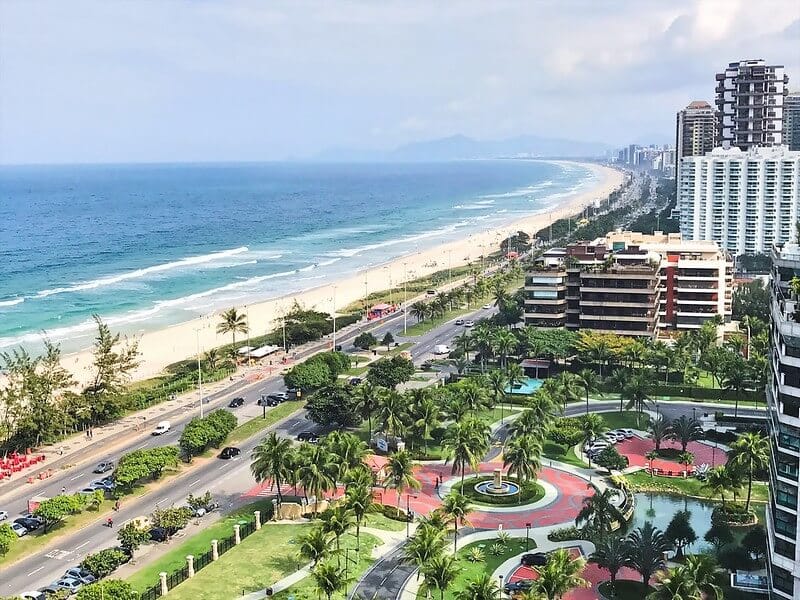
Barra da Tijuca is renowned for its expansive beaches, modern infrastructure, and sophisticated lifestyle. Its beaches are quieter and less crowded than those in the South Zone, making it an ideal retreat for those seeking relaxation and a closer connection to nature.
The most famous beach is Praia da Barra, but there are other notable options such as Praia da Reserva, Recreio dos Bandeirantes, and the wilder, more preserved Prainha and Grumari, perfect for those who enjoy a more natural environment.
Beyond the beaches, Barra offers a variety of shopping centers, including BarraShopping and VillageMall, which feature a wide range of stores, cinemas, and restaurants. The nightlife is lively, with bars and nightclubs that attract both locals and visitors looking for entertainment.
Barra is also a hotspot for major events and concerts, with venues such as Riocentro, Jeunesse Arena, and Cidade do Rock, the home of the famous Rock in Rio festival.
Barra da Tijuca is ideal for those looking for convenience and a more tranquil atmosphere, especially families or travelers who want to make the most of the local infrastructure. However, there are a few drawbacks to consider.
The distance from Rio’s main tourist attractions can be a challenge, as traveling to these sites can be time-consuming and costly, especially during rush hours.
While the metro now reaches Barra, its station is located at the beginning of the neighborhood, which limits mobility for those relying on public transportation.
Barra offers a wide range of accommodations, from luxury resorts to more affordable options, including vacation rentals.
However, the cost of lodging and other services in Barra tends to be higher than in popular South Zone neighborhoods like Copacabana but generally lower than in exclusive areas like Ipanema or Leblon.
Transportation costs are another important factor to consider. The neighborhood’s vastness often requires the use of private transportation, such as taxis or ride-hailing apps like Uber, which can significantly increase expenses, especially for frequent trips.
Barra is considered one of the safest areas in Rio, especially when compared to more central neighborhoods and some parts of the South Zone. This is largely due to its modern and planned layout, with gated communities, private security, and well-lit public spaces.
Areas near the beach, major shopping centers, and hotels are usually busy and monitored, which enhances the sense of security for tourists.
However, as with any urban area, it’s important to stay alert and follow basic safety precautions, such as avoiding the display of valuable items and being cautious in less busy areas, particularly at night.
Barra’s size and lower population density mean that some more remote areas can be deserted at certain times, posing a greater risk. Using private transportation or taxis/Uber for nighttime trips is a prudent measure for those who want to feel more secure.
👉 Explore hotels in Barra da Tijuca on Hoteis.com for spacious beaches and a relaxed atmosphere.
Central Zone
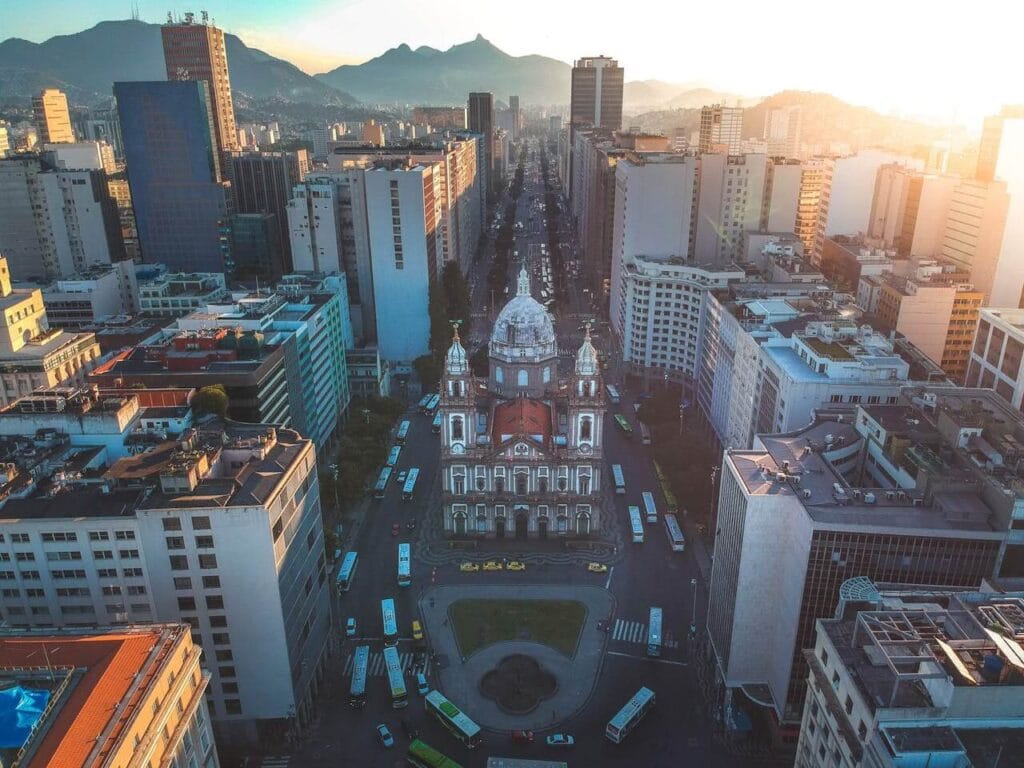
The Central Zone of Rio de Janeiro, or simply Centro, includes the neighborhoods of Centro, Lapa, and Santa Teresa.
In addition to being the historical and commercial heart of the city, the Central Zone has a strategic location. It’s the closest area to Santos Dumont Airport and Novo Rio Bus Terminal, making it convenient for those arriving by plane or bus.
Full of old buildings and historical landmarks, this is a busy area during the day, with lots of commercial activity and a concentration of famous attractions like the Arcos da Lapa, Escadaria Selarón, and the Museum of Tomorrow, located on the Boulevard Olímpico.
At night, the vibe changes—Lapa becomes lively with bars, samba clubs, and live music that attract locals and tourists, while other parts of the Centro tend to be quieter.
Staying in the Centro has its benefits. The area is close to major historical and cultural attractions, and many can be explored on foot or with short commutes.
Public transportation is also a big plus, with excellent metro, bus, and VLT (Light Rail) connections to other areas like the South and West Zones.
Another advantage is the cost-benefit. Accommodations in the Centro are generally more affordable compared to places like Copacabana or Ipanema. You can find everything from mid-range hotels to charming hostels in bohemian neighborhoods like Santa Teresa.
However, there are some downsides. Security in the Centro varies—some areas are busy and well-monitored during the day but can feel empty and less safe at night.
Additionally, the Central Zone doesn’t offer the peace of beachside neighborhoods or the natural scenery you’d find in other parts of Rio. Check out the main features of each neighborhood below:
Centro
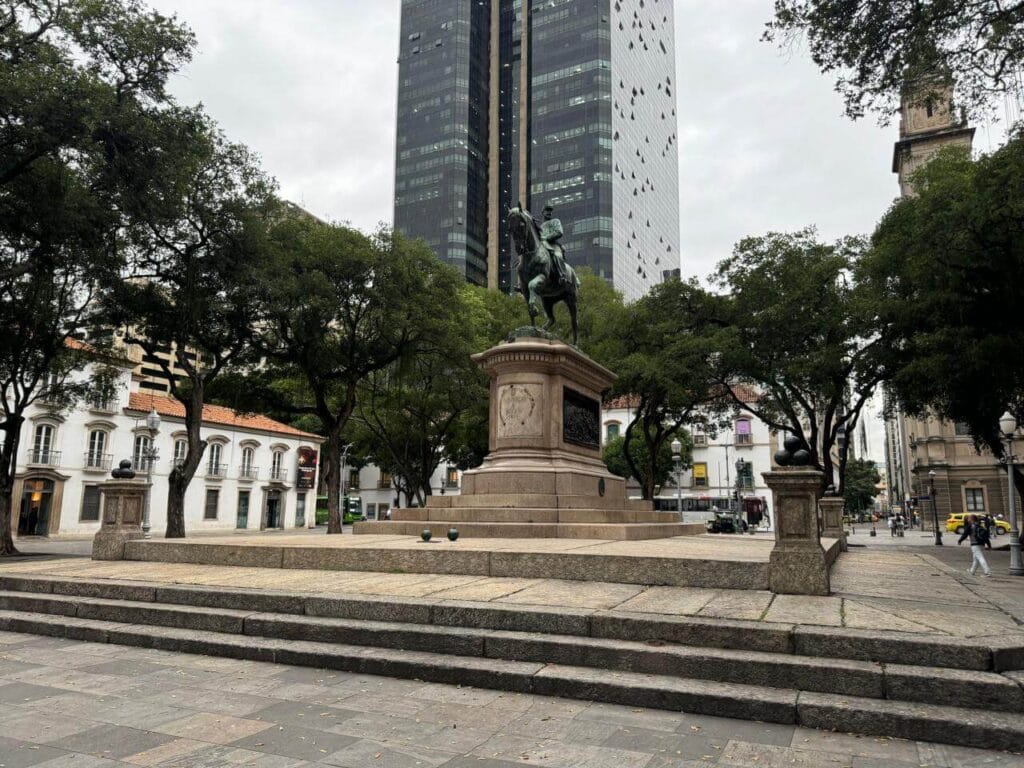
The Centro is Rio’s main commercial, financial, and historical hub, bringing together a wide range of attractions, services, and experiences.
During the day, it’s one of the busiest areas in the city, with intense business activity, crowds of workers, and visitors exploring its many landmarks.
Some highlights include the Theatro Municipal, Catedral Metropolitana, Real Gabinete Português de Leitura, Boulevard Olímpico, Museum of Tomorrow, AquaRio, and many others.
The Centro also stands out as the area with the best public transportation options in Rio, making it highly convenient for visitors and locals alike.
There are several strategically located metro stations, as well as the VLT (Light Rail), which connects the neighborhood to Santos Dumont Airport, Novo Rio Bus Terminal, and other key points.
A vast network of bus lines also provides access to nearly all parts of the city, including the South Zone, West Zone, and suburban neighborhoods.
When it comes to accommodations, the Centro is a practical choice, especially for business travelers or those wanting to explore Rio’s history and culture. The area offers some upscale options, but it’s best known for its budget-friendly hotels and hostels that deliver great value for money.
In terms of costs, the Centro is one of the most affordable areas in Rio for accommodations, with prices generally lower than those in the South Zone and West Zone.
Dining options are also diverse, ranging from popular restaurants serving traditional Brazilian dishes to more upscale gastronomic experiences in historic or cultural settings.
However, safety in the Centro is something to be mindful of, as the area varies depending on the time of day and location.
During the day, the Centro is bustling, and the sense of security is higher, especially in busy, well-monitored areas like the tourist landmarks. These zones often have visible policing, with patrols and surveillance.
As the day progresses and business activities wind down, many streets in the Centro can become deserted, especially on weekdays after work hours and during weekends. This lack of movement can make some areas more vulnerable to petty crimes like pickpocketing and theft.
Less-lit streets or those away from main routes require extra caution, and it’s advisable to avoid them, particularly at night.
Areas around metro stations and bus stops, while busy during the day, can also be hotspots for petty theft, especially during peak hours. Travelers should stay alert, keep personal belongings secure, and avoid showing valuables like phones, cameras, and jewelry in crowded spaces.
For nighttime outings in the Centro, it’s best to use taxis or ride-hailing apps instead of walking through isolated areas. Popular tourist spots like Lapa often have increased police presence, but it’s still important to follow basic safety tips.
Despite these challenges, safety in the Centro has improved in some areas due to urban revitalization projects, particularly around the Boulevard Olímpico and the Museum of Tomorrow, which are now well-monitored tourist destinations.
With proper planning, awareness, and an understanding of the safer zones, visitors can enjoy a more secure and pleasant experience while exploring this dynamic region.
👉 For an affordable and central stay, discover hotels on Hoteis.com in downtown Rio.
Lapa
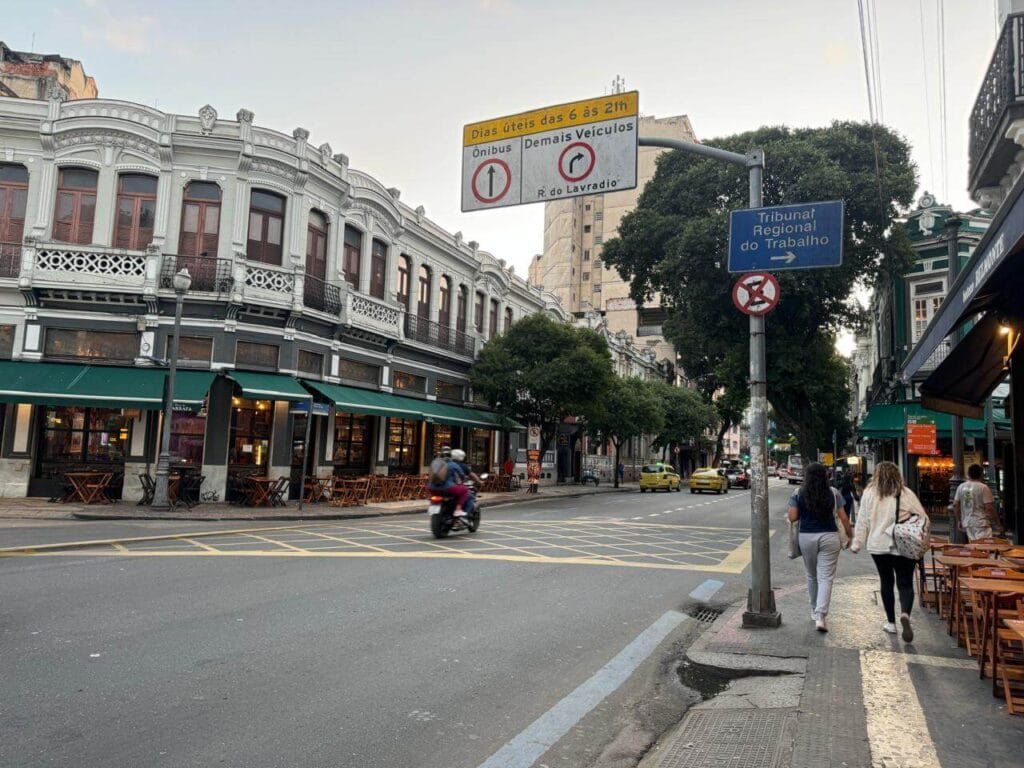
Located in the heart of the Central Zone, Lapa attracts both tourists and locals looking for fun, live music, and authentic experiences of Carioca culture, especially at night.
Dominated by the iconic Arcos da Lapa, a former aqueduct that now symbolizes the neighborhood, Lapa is a historical and cultural landmark of the city.
During the day, Lapa draws visitors to the Escadaria Selarón, one of the most photographed tourist spots in Rio. The area is also close to attractions like the Catedral Metropolitana and the Passeio Público, making it a strategic starting point to explore the Centro.
At night, Lapa transforms into the epicenter of Rio’s bohemian nightlife. Bars, restaurants, and music venues come alive, offering a wide variety of musical styles, from samba and choro to rock and electronic music.
Accommodation in Lapa caters to all budgets. From trendy hostels perfect for backpackers to mid-range hotels and guesthouses. Its proximity to the Centro and excellent public transport connections also make Lapa a convenient base for exploring other parts of the city.
When it comes to costs, Lapa is one of the most affordable areas in Rio. Accommodation prices are generally lower than in the South Zone or West Zone, making it a great choice for budget-conscious travelers.
Dining is also inexpensive, with a range of options from traditional Brazilian bars serving local dishes at accessible prices to more upscale restaurants that are still cheaper than those in neighborhoods like Ipanema or Leblon.
Public transportation, including buses and metro lines, is readily available, keeping travel costs low for those staying in Lapa.
Safety in Lapa, however, requires some attention. During the day, the area around the main tourist attractions is relatively calm and safe, with plenty of tourists, workers, and locals keeping it busy. Restaurants and cafés operating during the day are also well-frequented and monitored.
Police presence is noticeable in high-traffic areas, particularly near tourist landmarks. That said, like in any urban area, petty theft can occur, especially in crowded places. Keeping valuables out of sight, such as phones and wallets, is a good precaution to avoid issues.
More remote or less busy streets in Lapa can feel deserted during the day, especially outside regular business hours. It’s advisable to plan visits to well-trafficked areas or use public or app-based transportation for longer trips.
At night, Lapa attracts large crowds to its bars, restaurants, music venues, and clubs, especially on Fridays and Saturdays. The busy atmosphere makes popular spots like the Arcos da Lapa and Avenida Mem de Sá (Mem de Sá Avenue) relatively safe due to the high number of people and visible police presence.
However, the crowds can also attract pickpockets, so it’s important to stay alert and avoid displaying valuable items like phones, watches, or jewelry. Stick to busy areas, as poorly lit or deserted streets can pose greater risks.
For nighttime outings, using ride-hailing apps or taxis is highly recommended, particularly when leaving late-night events. Avoid walking alone through empty streets, even for short distances.
Santa Teresa

Santa Teresa is known for its cobblestone streets, historic mansions, and bohemian atmosphere, attracting artists, locals, and tourists seeking a more cultural and tranquil experience.
Perched on a hill in the Central Zone, the neighborhood offers stunning views of the city, with landmarks like the Parque das Ruínas and Largo dos Guimarães being must-visit spots for those exploring the area.
The neighborhood is full of art studios, charming cafés, and restaurants that blend sophisticated gastronomy with Rio’s laid-back spirit. Largo dos Guimarães serves as the heart of Santa Teresa, offering a variety of bars and cultural spaces that embody the neighborhood’s creative energy.
Its proximity to Lapa and Centro also makes it easy for visitors to enjoy Rio’s nightlife and historic attractions.
When it comes to accommodation, Santa Teresa offers unique options full of personality. Boutique hotels and cozy guesthouses provide a comfortable and intimate stay, perfect for couples or travelers looking for something off the beaten path.
Prices are varied, catering to those seeking luxury as well as budget-conscious travelers.
The dining scene in Santa Teresa caters to a range of tastes and budgets. From upscale establishments to simpler options, meal prices can vary significantly, but there’s something for everyone.
One of the main drawbacks of Santa Teresa is its accessibility. Being located on a hill, getting in and out involves navigating steep inclines. Visitors can travel via the famous Santa Teresa trams, buses, or on foot, depending on their energy levels.
Taxis and ride-hailing apps are also available, though some drivers may hesitate to accept trips to the area.
During the day, Santa Teresa is relatively calm and safe, especially in its tourist-friendly and busier areas like Largo dos Guimarães, Parque das Ruínas, and the main streets connecting key attractions.
The neighborhood receives many visitors, creating a welcoming and well-monitored atmosphere. Shops, restaurants, and open art studios contribute to keeping the streets lively and secure.
However, it’s important to be cautious in more isolated or less frequented parts of the neighborhood. Santa Teresa’s hilly topography and narrow streets mean some areas have less foot traffic.
Visitors should remain mindful of their belongings and avoid displaying valuables like cameras and phones, particularly in quieter spots.
At night, safety in Santa Teresa can vary depending on the location. Busy areas like Largo dos Guimarães, with its bars, restaurants, and cultural events, are generally safer, as they attract crowds of locals and tourists and occasionally have police patrols.
However, more remote and poorly lit streets can pose higher risks, especially for those walking alone or late at night.
To ensure a safe experience, it’s highly recommended to avoid walking alone on dimly lit or out-of-the-way streets after dark.
For nighttime transportation, using taxis or ride-hailing apps is the safest option, providing peace of mind when returning to accommodations or exploring the neighborhood.
Santa Teresa offers a unique blend of history, culture, and charm, making it a special part of any visit to Rio. With proper planning and awareness, visitors can enjoy this bohemian gem to the fullest.
👉 See the best boutique hotels and guesthouses in Santa Teresa on Hoteis.com, or compare artsy hostels on Hostelworld.



